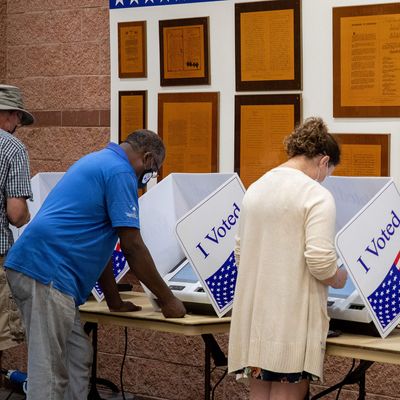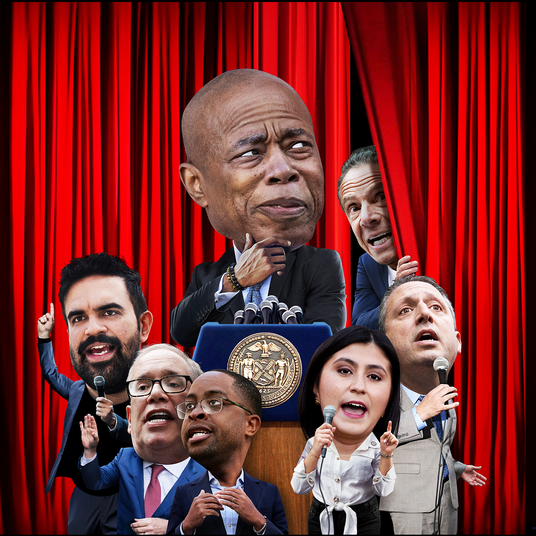
The ongoing fight over voting rights in the states and in Washington, D.C., obviously involves long-term stakes for both major political parties and their constituencies. But the first test of new laws and old struggles will come in the 2022 midterms, which, given the narrow Democratic advantages in Congress and the polarization over any and all legislation, could be very fateful. So it’s not a bad idea to ask what we know about likely 2022 turnout levels and patterns as we enter that cycle.
We won’t get too many indicators this year
Sometimes you can feel a midterm wave coming on via off-year regular and special elections. In 2017 and early 2018, for example, there was a bumper crop of 17 special congressional elections, with eight in at least somewhat-competitive districts and four producing a flip in partisan control. In 2021, there are currently six special congressional elections on tap and one that has already occurred. Only two are in districts with any significant chance of a change in party control. None will resemble the incredibly expensive slugfests we saw in House specials in Georgia and Pennsylvania in the off-year elections heading into 2018, or the Alabama special Senate election late in 2017. And as Larry Sabato’s Crystal Ball points out in an exhaustive review of special elections, they are not always reliable harbingers anyway.
Once upon a time, off-year gubernatorial elections in New Jersey and Virginia might have been closely watched for signs of what could happen next. But the blue trend in both states has made these elections less nationally relevant, although margins and trends could be interesting.
Turnout will be down from 2020, but probably still higher than usual
As Roll Call’s Nathan Gonzales observes, the last time midterm turnout exceeded that of the previous presidential contest was 1838. Since 2020 turnout was the highest in any national election since 1900, the midterm precedent won’t be shattered in 2022. The more pertinent question is whether 2022 turnout will reach that of 2018 (the highest since 1914) or more greatly resemble 2014 (the lowest since 1942). Gonzales speculates:
The average difference in turnout between a midterm and presidential election in recent history is 16 points. If that happens next year, it would put 2022 turnout back to the record midterm of 2018 at 50 percent. Obviously, that’s possible since it just happened, but with Trump out of the White House and potential voter complacency with the end of the pandemic and a growing economy, 2022 turnout could sink lower. In other words, less urgency could produce fewer voters.
Then again, we are living in a time when partisan passions are regularly compared to those of an actual civil war, which could put a floor on any plunge in “urgency.”
We don’t know who, more specifically, will turn out
Typically, midterms will bring out fewer “marginal voters,” which means the more regular voters, like seniors and college-educated people, usually make up a higher percentage of the electorate than in a presidential election. In pre-Trump 21st-century elections, alignment of higher-propensity voters with the GOP was thought to give Republicans a significant advantage in midterms (sometimes counterbalanced by a Democratic trend in those very segments of the election, as in 2006). Now, college-educated suburbanites and seniors are trending modestly toward Democrats, though Trump appeared to have boosted the propensity to vote of non-college-educated and rural white voters, who continue to trend Republican.
There are some midterms (most recently in 2010 and 2014) where one party’s “base” tends to turn out disproportionately across all demographic lines. That is often the party that does not control the White House, which is one reason the “out” party, with rare exceptions, makes midterm gains (though not always in the Senate, with its rotating election schedule).
The impact of changes in voting laws will be variable and possibly self-canceling
There are a lot of imponderables to consider in assessing the short-term impact of changes in voting laws. It’s obviously a fluid landscape; even in cases where voting restrictions have been enacted by Republican-controlled states like Arkansas, Georgia, and Iowa, litigation is still underway. And at the same time, Democratic-controlled states are moving quickly to enact expansions of voting opportunities.
Beyond those dynamics, there is a lot we don’t know about the actual impact of voting laws in 2020, given the unusual circumstances of a pandemic and a president determined to demonize voting by mail in order to set up an election challenge. Most academic research suggests that the partisan impact of this or that voting provision has probably been exaggerated. But it’s equally important to recognize that perceived effects may matter a lot in any event. The Georgia Republicans who enacted their state’s controversial new election law may have handed Georgia Democrats an ideal voter-mobilization tool for 2022. Simply knowing that Republicans don’t want them to vote could be incentive enough for young and minority voters to make an extra effort to show up.
Enthusiasm is impossible to predict right now
Precisely because “marginal voters” don’t tend to participate in midterms, relative “enthusiasm” for voting is often considered the key to the kingdom in midterms. Normally, it’s expected that when one party controls the federal government entirely, as Democrats do today, their voters could be prone to complacency. But then again, if Joe Biden is perceived by Democrats as being on the brink of doing great things, they could become more committed to making sure he has a Congress that will cooperate.
Meanwhile, Republicans, who would normally be expected to retain the motivation edge going into 2022, might waste “enthusiasm” in primary fights; at the moment, their party is less united than the Democrats. But based on the high turnout of the last two cycles and the maintenance of very high levels of polarization, it’s likely both parties will go into the midterms with highly enthusiastic rank-and-file membership, which could even get in the way of voter-persuasion efforts aimed at the small but pivotal numbers of true swing voters.
The you-know-who factor
There are many variables beyond the control of the parties affecting turnout and results for 2022, including a possible recurrence of a public-health emergency and the ups and downs of the economy. But one “known unknown” is whether Donald J. Trump manages to reinsert himself into the national and local political discourse in a big-footed sort of way. He is already threatening to purge Republicans who did not back his attempted election coup. But more generally, he may try to reassert his position as national party leader and potential 2024 Comeback Kid — or designate surrogates or successors to keep the MAGA fires burning.
If you believe Trump was a major contributor to high turnout in 2018 and 2020, it’s reasonable to assume his continued presence could spur Republicans to come out in droves to show their loyalty and Democrats to come out in droves to rebuke him again. If the 45th president does unexpectedly retreat from public life, turnout may not reach its potential highs for either party. But on the other hand, life will be better all around.






























